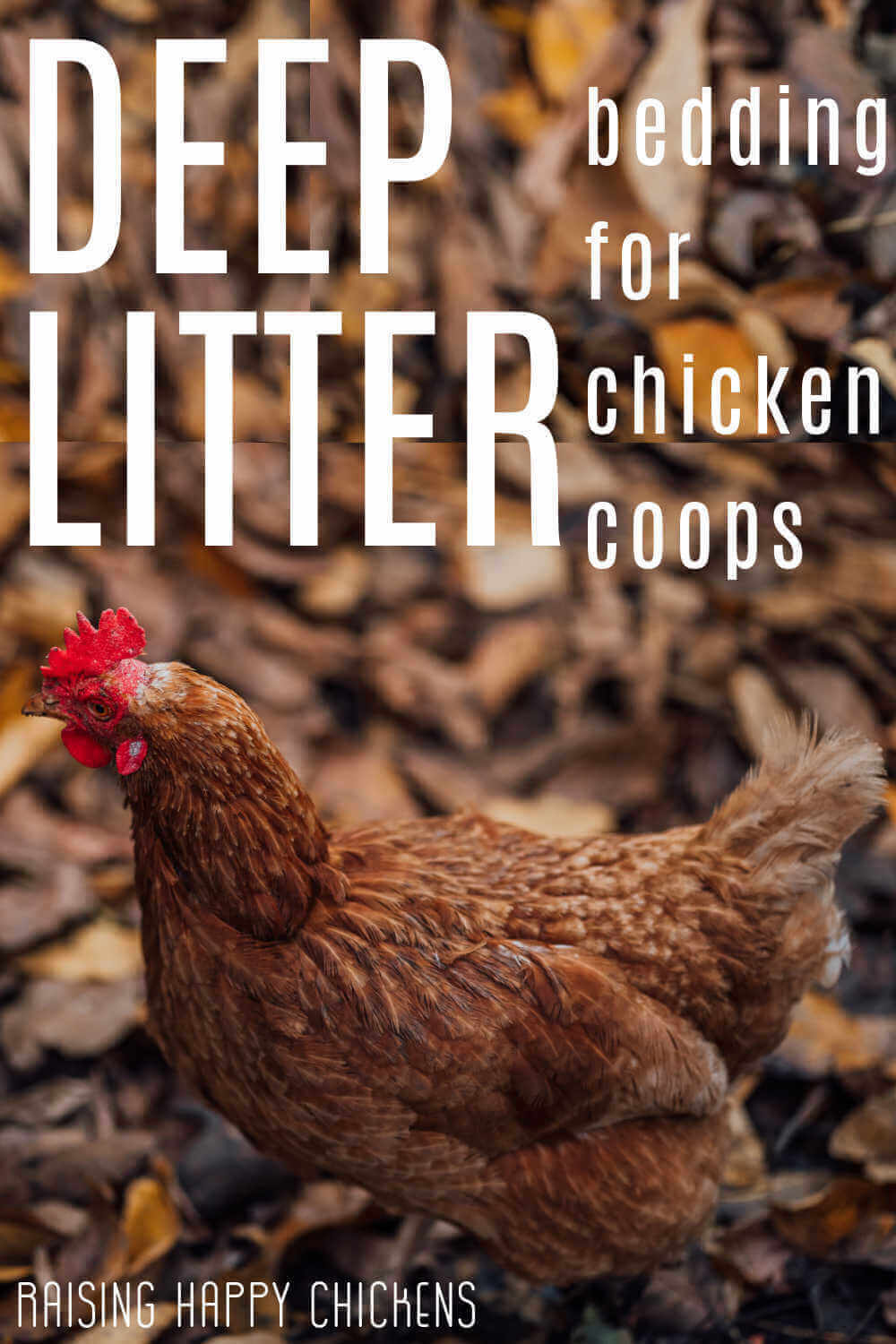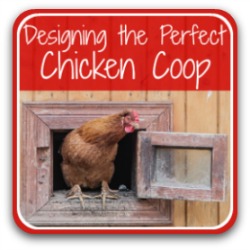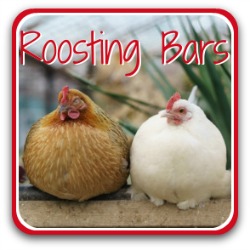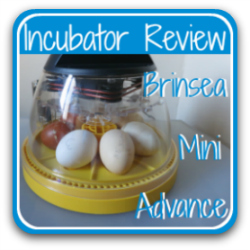The deep litter method in the chicken coop: what it is, how to do it and when to use it.
A natural, environmentally friendly way to keep chickens warm, healthy and happy in the winter.
If you've ever had a beautiful green space turned into a muddy brown mess by your flock, you may want to try this method, particularly in winter when greenery is hard to sustain.
For instead of your chickens destroying your garden, it encourages them to scratch and forage within their own litter.
It can be a win-win-win!
- inexpensive and simple for you to create and manage
- an improvement to your flock's environment - and yours
- a proven way of enhancing their health and welfare
- a natural, sustainable way of enhancing your coop, especially in the winter.
It's not without issues, though, and it's not the answer for everyone.
Your responsibility is to read properly researched information about the system and its benefits and drawbacks, and decide whether it's an option you want to try for your individual circumstances.

Want a particular section?
This is a long article. Use these links to get quickly to the section you want. Otherwise, read on for the details.

The deep litter system: what exactly is it?
It's a system of bedding in the chicken coop which has existed since World War II, when it was introduced because it saved both labour, and bedding materials which were hard to access.
The idea is simple and has the same basic principles as creating a compost heap in your garden.
Instead of cleaning bedding out of the coop regularly, it's left in and more added to it so that it becomes deep. The initial study called it "built-up litter" to make clear that it's not the depth, but building in layers of bedding that is critical.
An initial layer absorbs nitrogen from chicken droppings to break down into a nutrient rich compost-type material. More layers are added as the initial layer composts down.
Just like your garden compost bin, the materials develop not only bugs, but beneficial micro-organisms.
The decomposition creates heat, which helps insulate the coop and provide some extra warmth.

Pros of using the deep litter method.
The general view on various websites and blogs is that the main benefit of this method is that it saves time.
That's missing the most important point: it has been shown to result in healthier chickens.
The United Nations Department of Food and Agriculture, for example, is clear:
"Micro-organisms thrive on the manure in the litter and break it down. This microflora produces growth factors, notably vitamin B12, and antibiotic substances, which help control the level of pathogenic bacteria. Consequently, the growth rate and health are often superior in poultry raised on deep litter."
Both the pros and cons of using the deep litter method listed here are taken from the results of properly undertaken studies. See the sources section for details and links.
- Mortality rates in large chicken farms reduced, mortality rates among chicks were halved (1)
- Specifically, beneficial microbes present in deep litter help build immunity to coccidiosis in both adult and young chickens(1)
- Rates of Salmonella were found to be lower in deep litter raised chickens(1)
As well as the scientifically produced results, there's evidence that the deep litter method...
- Provides activity for chickens during winter months when they're not able to forage as freely
- Contributes positively to the environment by providing a system which adds benefit (the resulting compost) rather than draining it (by adding excessive nitrogen to land)
- Is more economical, since the best bedding materials (after the initial layer) can be gathered for free
- Allows chickens to exhibit natural behaviours critical for their welfare such as foraging and dust-bathing.

Cons of deep litter bedding.
Despite proven benefits, the deep litter system is not all plain sailing. Some evidence was contradictory, for example some studies showed an improvement in egg production and quality, others found none(4).
And critically, it must be properly managed or the benefits are completely lost and worse, it may become a health hazard and actively cause damage.
- Unless the system is kept active, the beneficial micro-organisms will not thrive and there will be no immunity to cocci
- A build up of ammonia in the system means it's failing, and can cause respiratory and other health issues for the flock
- To work effectively, there must be some moisture under the top layer. Poor drainage and inadequate ventilation can see this build up and create a growth in bedding mould and the spread of disease
- It does not work well in areas of high humidity or with waterfowl (such as ducks)
- It can be hard to continuously find appropriate bedding.

A quick start summary of how to do the deep litter method in a chicken coop.
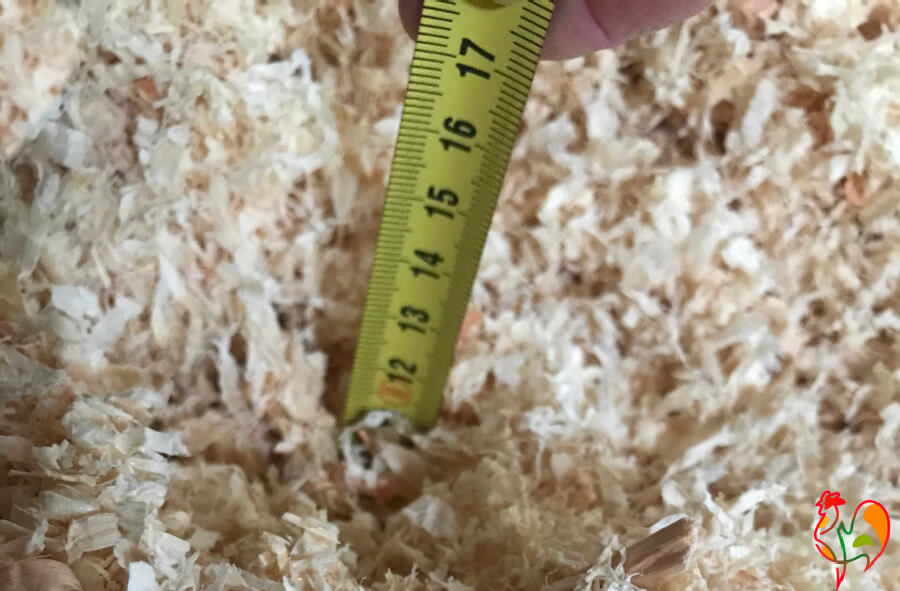 The first layer of bedding should be at least 10cm (4") - preferably more.
The first layer of bedding should be at least 10cm (4") - preferably more.This method can be used in any size of coop. It works best with an earth floor, but can be used with concrete or plastic (such as in an Eglu) - see step 2.
Wooden floors can be used but aren't ideal since they can absorb the moisture created by the composting materials, including the poop. That will cause your wooden floor to rot more quickly.
Here are the basic steps. See the rest of the article for more detail.
1. Prepare the floor by cleaning out any residual dirty bedding. If you've used the deep litter method before, leave a few centimetres of the old bedding since it will speed up the decomposition process.
2. If you have a concrete floor, there's a danger of lack of drainage and microbes not multiplying. Add an inch or so of compost before laying the bedding.
3. Add your first layer of bedding to a depth of between 10 and 15 centimetres (4" and 6"). Make sure this layer is super-absorbent. See below for ideal bedding.
4. Encourage scratching by the chickens by scattering some grain and treats such as mealworms or sunflower seeds into the bedding.
5. Turn the bedding from time to time and make sure there's no moisture building up. If you start to smell ammonia, the method is not working.
6. Keep the bedding at a depth of at least 10 - 15 centimetres by adding new litter as it starts to decompose. See below for ideal additional bedding ideas.
7. Allow the bedding to build up to a depth of about 30 cm (12") before removing any. At that point, take off some of the decomposed material and add fresh bedding on top.
8. Add the bedding you remove to your garden or vegetable plot. If it's not quite decomposed, add it to your compost heap to finish.
Deep litter in the chicken run.
The deep litter method must be controlled, particularly in terms of moisture.
If you have a covered run, it may be possible to use it in the there. But if your run is exposed, it's more likely to cause problems than solve them.

Is it good to use all year round?
It can be used right through the seasons, but works best during the winter.
That's because the composting materials create heat, which helps make the coop just a little less cold. Chickens don't need additional heat in the winter but many people like to add it in the shape of heat lamps.
That has drawbacks, chief amongst which is the risk of fire. Using deep litter instead is completely natural and requires no electricity - a definite bonus.
Deep litter doesn't create massive heat, so it can still be used in summer. However, if your flock is outside in good weather, they may not be in the coop often enough to keep the bedding turned. In that case, you'll need to aerate it yourself.

Step 1: know when and how to start.
Given that it takes time for the litter to start decomposing, it's best to start in the early autumn (fall) so that by the time a hard winter sets in, the bedding has begun to decompose and warm up.
Begin by clearing out your existing bedding, particularly if you've used sand which does not work well with deep litter, or straw which is not absorbent enough at the start.
If you have a concrete floor, put down a layer of potting or garden compost before you start. You'll need about 2.5 centimetres (1"). This provides the earth base necessary for both absorption and microbe activity.

Step 2: the initial bedding layer.
(Links in this section are "affiliate links", which means that if you click and buy something, I earn a small commission at no extra cost to you)
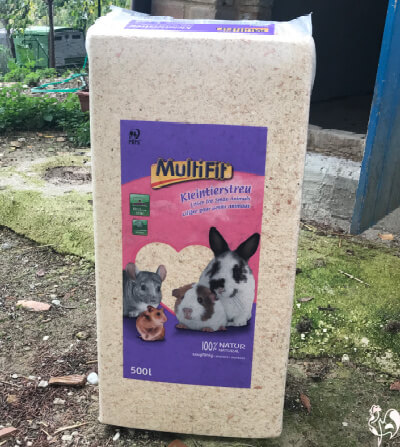 My wood shavings waiting to be laid.
My wood shavings waiting to be laid.It's important that the initial layer is carbon based, absorbent and fine enough to begin breaking down quickly.
Avoid materials like straw and grass which is not absorbent and more likely to become wet and mouldy.
Studies found the ideal to be wood shavings, which is what I use. They're fine enough to begin the process of decomposition quite quickly.
Make sure it's not treated or scented, and go for a good brand - otherwise you'll find there's a lot of sawdust which is not good for your respiratory system - or your chickens'.
Something like this is ideal.
I use about 1.5 x 500 litre bags for a coop which is about 3 metres x 2 metres (9' by 6'). It's an expensive initial outlay, but it will be the only one you'll need for at least several months.
Hemp bedding is an excellent alternative, and said to be more absorbent.
The bedding will be compressed, so you'll need to break it up and spread it once it's unbagged.
Rake it to a depth between 10cm - 15cm (4" - 6"). To stop it being kicked all over the run, I use a 15cm (6") high wooden plank placed between the pop door and the door into my egg-laying part of the coop (where I don't use bedding).
Not only does it keep the shavings within the coop, its height conveniently shows me how deep the litter is.
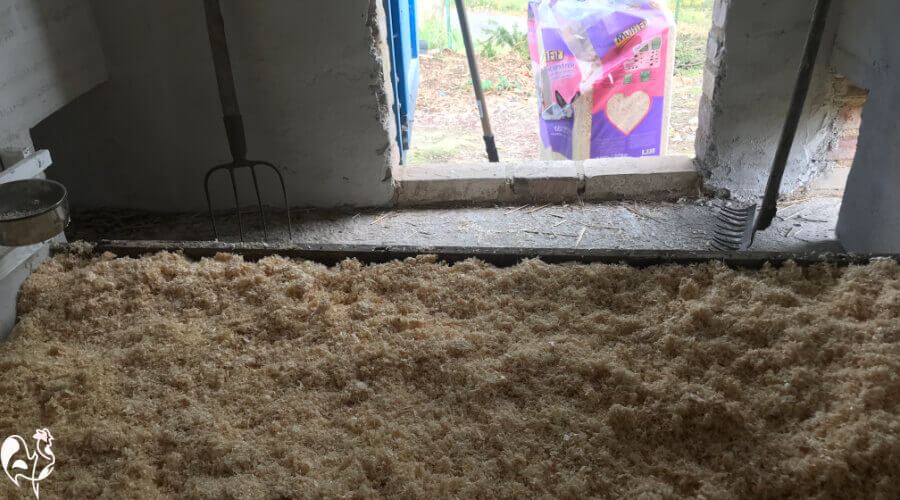 The pristine initial deep litter layer in the roosting part of my coop.
The pristine initial deep litter layer in the roosting part of my coop.Once that's done, sprinkle a few mealworms or sunflower seeds into the bedding to encourage your chickens to start digging.
And that's it for the first layer. We'll leave it to work with the droppings to start establishing those beneficial micro organisms.
Keep an eye on it to make sure the chickens are turning it over. If you see any clumps, break them up with a pitchfork or rake and turn them into the rest of the bedding.

Step 3: add other layers
Next, we will add other layers in on top of that initial layer, and without removing any of it. Adding in a fresh layer just a centimetre or two deep every few days should be plenty.
If you start to notice moisture, or a smell of nitrogen, add more.
Avoid anything that may contain pesticides or chemicals, including paint.
Suitable materials for this can generally be found for free, and include:
- dried leaves
- chopped straw (not too much - it's not absorbent enough)
- grass clippings
- pine needles
- chipped bark
- chipped bamboo.
A note about bamboo.
It can sometimes be hard to find enough second layer bedding to add to your deep litter, particularly if you have a large coop.
I've found that bamboo can be a great source, although in some places it's viewed as invasive and does need to be controlled.
It's common for families here in rural Italy to grow some for personal use, so it made sense for me to try using some from our own patch, which grows close to the chicken run.
 Bamboo: shelter, windbreak and bedding in one plant!
Bamboo: shelter, windbreak and bedding in one plant!I've found it to be ideal. It grows quickly, is sustainable, provides shade in the summer, a wind break in the winter, and sheds leaves which get used in the coop.
And I can put the bamboo canes through a basic shredder for use as deep litter.
Important: Diatomaceous Earth and deep litter.
Do not use diatomaceous earth in a deep litter system, even if you’re trying to control for parasites like mites and lice. Use it outdoors in a dust bath or run instead.
The reason for this is that diatomaceous earth will kill off the beneficial microorganisms you are trying so hard to promote, and the benefits of the system will be lost.

Step 4: how to keep managing it.
You may see comments around the internet that the deep litter method is best because it needs no upkeeping.
That's not true. It takes careful managing to make sure the system remains a healthy environment.
1. Control moisture.
One of the difficulties of any bedding is keeping it free from moisture, and it's a particular dilemma with the deep litter method.
The litter has to have some moisture in order to turn to compost. But too much will mean wet bedding which can cause respiratory and other illnesses.
Chicken droppings are high in moisture so there's no need to add any. To stop it (or any bedding) from becoming overly wet you should...
- keep waterers outside the coop - chickens don't drink at night anyway
- make sure ventilation in the coop is adequate: there should be a good flow of air above the chickens' heads when they're roosted, without allowing draughts
- break up any clumps of bedding and turn them into the rest of the bedding. If your flock is outside for most of the time, they may not turn the bedding as much as it needs, causing it to become damp and clump.
How to know when the litter is too wet?
- As the litter starts to turn to compost, grab a handful and squeeze. No water should drip from it. It should hold its shape and, as you release it, crumble into a rich humus.
- Always keep your nose open. A deep litter that's not working efficiently will begin to smell of ammonia which will cause respiratory illness. Clean it out and start again.
2. Manage aeration.
Your chickens should turn the bedding themselves, particularly as it starts to decompose and attracts bugs and worms. But this doesn't always work.
It may be that...
- you have too few chickens for the area needing to be turned
- they're outside the coop for most of the time
- the system isn't working properly so there are no interesting bugs to encourage the flock to forage.
Inspect the floor frequently; turn the bedding and break up any clumps, or areas looking white. Turn them into the rest of the bedding.
3. Be patient in allowing build-up.
To work efficiently, and for the bedding to reach a temperature which helps keep the coop warm, it should reach a depth of about 30 cm (12").
That can take several months, depending on the type of floor it's built on.
Turn it, and remove bit by bit. Never remove it all at once - the already decomposed litter will be a "quick jump start" for new bedding.

Is the deep litter method right for you?
My chickens love it. They even help with spreading the layers.
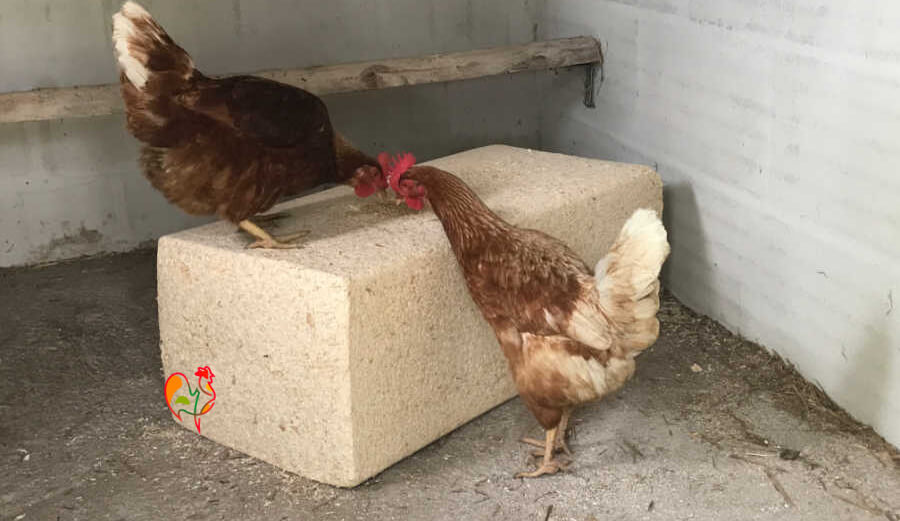 This bedding takes some unpacking - helped by chickens!
This bedding takes some unpacking - helped by chickens!Some people swear by it. Others say it's likely to cause more problems than it solves. I use it in the winter and tend to change in the summer for sand, which I find is cooler for my flock in the heat.
Will it work for you?
It depends on your coop, your flooring, your chickens (and whether they're prepared to work it!) and your patience.
The only way you know, as with most things chicken related, is by taking account of all the information you have access to here, and trying it.

If you found this article useful, you may also like these.

Sources.
A lot of "facts" you'll find on the internet are often people's individual views, based on inaccurate information repeated from poor quality sources.
The information I provide in this article and others is based not just on my own experience, but on evidenced facts from scientific, peer-reviewed research and books from highly respected and experienced poultry keepers such as Gail Damerow.
Some of the trusted sources I have used in this article are these.
1. Kennard, D. C. et al: The Compost (Built Up) Litter in Chicken Houses. Pub. Ohio Agricultural Experiment Station, 1959.
2. Sogunle, O, et al: Free range and deep litter poultry production systems: effect on performance, carcass yield and meat composition of cockerel chickens. Pub. Journal of Tropical Animal Health and Production, 2021.
3. The deep litter system of poultry farming. Pub. Journal of Poultry Science, 2020.
4. Oluyemi, J. A, and Roberts, Y. O: The Cage Versus the Deep Litter System for the Management of Layers in the Humid Tropics. Pub. Journal of Poultry Science, 1975.
5. Li, Hui: Design of Moisture Control System for Beddings of Deep Litter. Pub. Journal of Agricultural Science and Technology, 2014.
6. Thiele, H-H, and Pottgüter, R: Management Recommendations for Laying Hens in Deep Litter, Perchery and Free Range Systems. Pub. Lohmann Tierzucht, 2008.
